February 4 Scots Book of Days
February 4 Ash Wednesday earliest date, while March 10 is the latest; 46 days before Easter Day celebrated on the first day of Lent. (Christian).
211 Roman Emperor Septimius Severus died at Eboracum, province of Britannia (modern York, England) while preparing to invade Caledonia. Caledonia was the Roman name for Scotland, north and beyond the frontier of the Roman empire. Tacitus, Ptolemy, Lucan and Pliny the Elder, used Caledonia for the area also known as Pictavia or Pictland north of Hadrian’s Wall in today’s Scotland.
| Emperor Hadrian in the Louvre Paris |
1189 Gilbert of Sempringham, Founder of the Gilbertine Order.
1314 Around Lent of 1314 Edward Bruce, brother of the Scottish king, began the siege of Stirling Castle, which was commanded by Sir Philip Mowbray. Unable to make any headway, Bruce agreed to a pact with Mowbray – if no relief came by midsummer 1314, the castle would surrender to Bruce.
Brus or Bruce 1050 2 Stewart2 Kennedy2 Montgomery2 Blair2 Cochrane2 Miller2 Simmons2 Choate2 Luke ToaG
1413 A schism in the (Roman Catholic) Church had two rival papacies. Scotland believed that the Avignon Pope, now exiled in Peñiscola, was the lawful Pope. Accordingly, confirmation was sought from Pope Benedict XIII and in August 1413 a series of Papal Bulls were issued. With their promulgation in St Andrews Priory on 4 February 1414, the University of St Andrews began. The six bulls included the bull of foundation and a bull confirming Wardlaw’s charter of 1411. Although the text of all six is known, only the confirmation of Wardlaw’s grant survives in the original and still bears its bulla or lead seal. http://www.st-andrews.ac.uk/600/history/timeline/
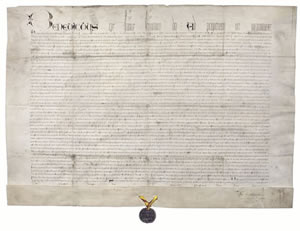 Charter of incorporation and privileges from the Bishop, Henry Wardlaw.
Charter of incorporation and privileges from the Bishop, Henry Wardlaw.
1559 On 4 February One of 24 Lords of the Congregation. James Hamilton, 3rd Earl of Arran (c1532–1609). Fife was won over to the Congregation and pacified. Later in February, Thomas Randolph posed as a Scot to gain the confidence of a French agent at Dumbarton Castle but Arran clumsily revealed his identity. During the Spring the centre of the conflict in Scotland moved to the Siege of Leith with the intervention of an English land army enabled by his father’s Treaty of Berwick. Before the English army arrived, the French raided Glasgow and attacked the Bishop’s Palace, Arran shadowed their return to Leith with a force of 800 horsemen. He then joined the besiegers in the camp at Restalrig.
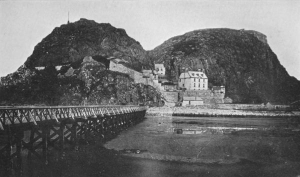 DUMBARTON CASTLE. The Spell of Scotland by Keith Clark, 1916 to the Lord Marischall, Boston The Page Company. P.282
DUMBARTON CASTLE. The Spell of Scotland by Keith Clark, 1916 to the Lord Marischall, Boston The Page Company. P.282
1593 Sir Gilbert Gerard who was Attorney General for Elizabeth 1st, dies and is buried at Ashley, Staffordshire. Elizabeth’s support during the Seige at Leith in 1559 and 1560 concluded the Reformation in Scotland.
1599 never happened in Scotland. Dating its years from the birth of Jesus Christ, so that ‘’ every nation, kindred, every ear shall hear, every knee shall bow, and every tongue shall confess, Jesus Christ is Lord,’’ thru computer software applications and aviation, the Christian calendar has been adopted world wide for the Musselmen of Islam, the Buddhist, Confucian, Hindu, nativist, Jew, agnostic, or atheist (Isaiah 45:23, 1 Kings 19:18, Philippians 2:11, Romans 14:11, confirmed in modern times Mosiah 16:1 Mosiah 27:31 Doctrine and Covenants 76:110, Doctrine and Covenants 88:104
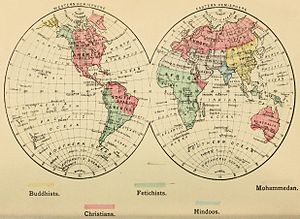 An 1883 map of the world divided into colors representing “Christians, Buddhists, Hindoos, Mohammedans, Fetichists”.
An 1883 map of the world divided into colors representing “Christians, Buddhists, Hindoos, Mohammedans, Fetichists”.
1600-1607 circa sometime. William Row was settled minister at Strathmiglo, in the shire of Fyfe, about the year 1600, and continued there for several years, and son of Minister John Rowat Perth. Being at Edinburgh, before the assembly there, at which the king [James 6th] wanted to bring in some innovation, and meeting with Mr. James Melvil, [Mr. was the abbreviation for Minister] who was sent for by the king [James 6th], he accompanied him to Holyrood-house. While Mr. Melvil was with the king [James 6th], Mr. Row stood behind a screen, and not getting an opportunity to go out with his brother undiscovered, he overheard the king [James 6th] say to some of his courtiers, “This is a good simple man, I have stroked cream on his mouth, and he will procure me a good number of voters, I warrant you.” This said, Mr. Row got off, and overtaking Mr. Melvil, asked him, what had passed? Mr. Melvil told him all, and said, The king [James 6th] is well disposed to the church, and intend to do her good by all his schemes. Mr. Row replied, The king [James 6th] looks upon ye as a fool and a knave, and wants to use ye us a coy duck to draw in others, and told him what he had overheard. Mr. Melvil suspecting the truth of this report, Mr. Row offered to go with him, and avouch it to the king’s face; accordingly, they went back to the palace, when Mr. Melvil seeing Mr. Row as forward to go in as he was, believed his report and stopped him: And next day, when the assembly proceeded to voting, Mr. Melvil having voted against what the king proponed, his majesty would not believe that such was his vote, till he, being asked again, did repeat it.
Biographia Scoticana: OR, A BRIEF HISTORICAL ACCOUNT OF THE LIVES, CHARACTERS, and MEMORABLE TRANSACTIONS of the most eminent SCOTS WORTHIES, Noblemen, Gentlemen, Ministers, and others: From Mr. Patrick Hamilton, who was born about the year of our Lord 1503, and suffered martyrdom at St. Andrews, Feb. 1527, to Mr. James Renwick, who was executed in the Grass-market of Edinburgh Feb. 17, 1688. together with a succinct Account of the Lives of other seven eminent Divines, and Sir Robert Hamilton of Preston, who died about, or shortly after the Revolution. as also, An Appendix, containing a short historical Hint of the wicked Lives and miserable Deaths of some of the most remarkable apostates and bluidy persecutors in Scotland from the Reformation to the Revolution. Collected from historical Records, Biographical Accounts, and other authenticated Writings:—The whole including a Period of near Two Hundred Years. By John Howie – 178181
1624 Patrick Ruthven permitted to reside in Somerset. In February 1639–40 he was living in St. Martin’s-in-the-Fields. He died in 1652, in the king’s bench prison. He married Elizabeth, daughter of Robert Woodford, and widow of Thomas, lord Gerard, by whom he had, besides other children, Patrick, who succeeded him, and Mary, maid of honour to Queen Henrietta Maria, who married Sir Anthony Vandyke. Thomas Gerard’s descendants also colonized Virgina. (Queen Henrietta Maria is the namesake for the American state of Maryland, from which the District of Columbia was carved in 1789.)
Martin (St. Martin) – Florida Indiana Kentucky Louisiana Minnesota, North Carolina, Texas,
1716 Chevalier de St George, James VIII, leaves for boat. TG 73-421
1642
1716 Montrose Angus Scotland. James Francis Edward Stuart (the auld Pretender; formerly James, Prince of Wales, James III) arrived in Montrose, where he spent his last night in Scotland. James sailed from Montrose to his final exile in France. The town was held for his son, Charles Edward Stuart (Bonnie Prince Charlie; the Young Pretender), 30 years later and in February 1746 the largest naval battle of the war was fought in Montrose Harbour. Samuel Johnson made a tour of Montrose on his visit to Scotland in the 1770s. Johnson said:
“…we travelled on to Montrose, which we surveyed in the morning and found it well-built, airy, and clean. The town house is a handsome fabrick with a portico. We then went to view the English chapel, and found it a small church, clean to a degree unknown in any other part of Scotland, with commodius galleries, and what was yet less expected, with an organ.”
1717 Duke of St Andrews and Castelblanco created 4 February 1717 for de Rozas became dormant for José de Rozas, Conde de Castelblanco, Knight of the Order of Alcántara, Captain-General of Guatemala, son-in-law of the 1st Duke of Melfort. Marquess of Borland created 4 February 1717 for de Rozas became dormant subsidiary title of the Duke of St Andrews and Castelblanco.
1732 John Armstrong M.D. took degree as medical physician.
Armstrong17th 2Warren2Mehew2Luther2Choate zoe
In 1737 Armstrong received 50 pounds from Andrew Millar, the bookseller for a poem ‘The economy of Love.’ 1744 Armstrong published ‘The Art of Preserving Health’ in blank verse. 1746 Armstrong was physician to hospital for sick and lame soldiers. 1751 Benevolence. 1753 Epistle on Taste. 1758 ‘Sketch or Essays on various subjects, by Lancelot Temple, Esq. 1760 physician to the army in Germany.
1751 did not occur in England, Ireland, British North America, and British colonies, as 1751 only had 282 days due to the Calendar Act of 1750. But 1751 did occur in Scotland, as 1751 had 365 days. The Julian calendar, introduced by Julius Caesar in 46 BC (708 AUC), was a reform of the Roman calendar. It took effect in 45 BC (709 AUC). It was the predominant calendar in most of Europe, and in European settlements in the Americas and elsewhere, until it was refined and superseded by the Gregorian calendar. The difference in the average length of the year between Julian (365.25 days) and Gregorian (365.2425 days) is 0.002%.
1789 – George Washington is unanimously elected as the first President of the United States by the U.S. Electoral College.
1814 Peace talks at Chatillon, Napoleon disputed. Tytler’s Britannica.
1818 February 4, Sir Henry Jardine, was one of those present including Sir Walter Scott, when the Honours of Scotland were re-discovered in 1818 at Edinburgh Castle. Also known as the Scottish regalia and the Scottish Crown Jewels, dating from the fifteenth and sixteenth centuries, are the oldest set of crown jewels in the British Isles. The existing set date from James V, and were used for the coronation of Scottish monarchs from 1543 (Mary, Queen of Scots) to 1651 (Charles II).
 Rediscovering the Honours in 1818. Tableau at Edinburgh Castle. The English crowns were melted down under Cromwell, but the Scot’s crown were hidden. Until the Acts of Union 1707, which united the Kingdom of Scotland and the Kingdom of England to form the unified Kingdom of Great Britain, the Honours of Scotland were taken to sittings of the Parliament of Scotland to represent the Monarch who, since the Union of the Crowns, in 1603, resided in England. After the Act of Union, the Parliament of Scotland and Parliament of England having been dissolved, the Parliament of Great Britain sat in London; the Honours of Scotland, having no symbolic role to play in the unified British Parliament, were placed in a chest and locked away at Edinburgh Castle. There they remained, almost forgotten, until 4 February, 1818 when a group, including Sir Walter Scott, set out to recover the Honours.
Rediscovering the Honours in 1818. Tableau at Edinburgh Castle. The English crowns were melted down under Cromwell, but the Scot’s crown were hidden. Until the Acts of Union 1707, which united the Kingdom of Scotland and the Kingdom of England to form the unified Kingdom of Great Britain, the Honours of Scotland were taken to sittings of the Parliament of Scotland to represent the Monarch who, since the Union of the Crowns, in 1603, resided in England. After the Act of Union, the Parliament of Scotland and Parliament of England having been dissolved, the Parliament of Great Britain sat in London; the Honours of Scotland, having no symbolic role to play in the unified British Parliament, were placed in a chest and locked away at Edinburgh Castle. There they remained, almost forgotten, until 4 February, 1818 when a group, including Sir Walter Scott, set out to recover the Honours.
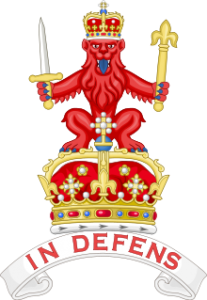 Crest of the Royal coat of arms of Scotland, depicting representations of the Honours of Scotland: Crown, Sword and Sceptre.
Crest of the Royal coat of arms of Scotland, depicting representations of the Honours of Scotland: Crown, Sword and Sceptre.
On August 22nd and 23rd 1877, Wilford Woodruff, later reported that three knights, among others, Sir Walter Scott ‘called upon me, as an Apostle of the Lord Jesus Christ, in the Temple at St. George, two consecutive nights, and demanded at my hands that I should go forth and attend to the ordinances of the House of God for them.’ A high honor indeed!
1831 Joseph Smith the Prophet, at Kirtland, Ohio, (clan Mack of Inverness, Malcolm King of Scots). Doctrine and Covenants 41. For it is not meet that the things which belong to the children of the kingdom should be given to them that are not worthy, or to dogs, or the pearls to be cast before swine.
1846 – The Church of Jesus Christ of Latter-day Saints pioneers exodus Nauvoo, Illinois, westward towards Iowa and Nebraska Territory. The Mississippi river conveniently froze solid so as to permit loaded wagons, horses, teams, livestock and refugees, to cross without the need for rafts and the delay of boats, and dangers of capsizing into freezing water. The Church’s first prophets, seers and revelators, the brothers Joseph and Hyrum Smith (died 1844) descend from the clan Mack of Inverness.
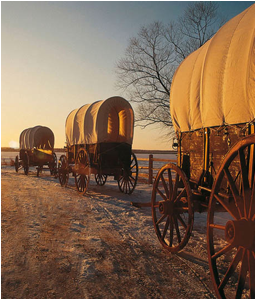 Evacuation of Nauvoo, Illinois. www.lds.org/scriptures/history
Evacuation of Nauvoo, Illinois. www.lds.org/scriptures/history
1861 – American Civil War: In Montgomery, Alabama, delegates from six break-away United States meet and form the Confederate States of America.
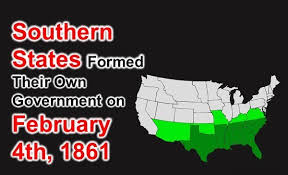 Scotland’s Cross of St Andrew prominently displayed.
Scotland’s Cross of St Andrew prominently displayed.
1919 Previous winner of the 1905 The John Scott Legacy Medal and Premium, John Moses Browning (January 23, 1855 – November 26, 1926), received patent. Browning was a member of The Church of Jesus Christ of Latter-day Saints.
The druggist John Scott of Edinburgh organized a $4,000 fund in 1816 for The John Scott Legacy Medal and Premium, to be presented to an inventor whose inventions improved the “comfort, welfare, and happiness of human kind” in a significant way.  The Franklin Institute and the City Council of Philadelphia.
The Franklin Institute and the City Council of Philadelphia.
The Patent U.S. Patent 1,293,022 Browning Automatic Rifle Model of 1918
 Rifle, Caliber .30, Automatic, Browning, M1918
Rifle, Caliber .30, Automatic, Browning, M1918
1998 Adam joseph Choate born. (clan Stewarts of Angus, Atholl, Avandale, Bonkyl, Buchan, Lennox, Methven, Ohiltree, Traquair)
2012 February 4. The Missionary Training Center in Provo Utah has a replica of a large stone bearing the words ‘What E’er Thou Art Act Well Thy Part.’ According to Apostle Russell M. Nelson, Elder David O. McKay related that in 1897, Elder McKay began serving a mission in Scotland. [David McKay from Caithness Scotland reared a son, David O. McKay who became president of the Church of Jesus Christ of Latter-day Saints.] After a few months, on March 26, 1898, upon returning from Stirling Castle,
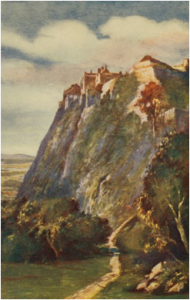 Stirling Castle. The Spell of Scotland by Keith Clark, 1916 to the Lord Marischall, Boston The Page Company. P.304.
Stirling Castle. The Spell of Scotland by Keith Clark, 1916 to the Lord Marischall, Boston The Page Company. P.304.
Elder McKay and his companion saw the stone above the entrance to an architect’s office, with that motto.’ I said to myself, or the Spirit within me, ‘You are a member of The Church of Jesus Christ of Latter-day Saints.’ President McKay later related, ‘More than that, ye are here as a representative of the Lord Jesus Christ. Accepting the message given to him on the stone, ‘from that moment we tried to do our part as missionaries in Scotland.’ Church News February 4, 2012.
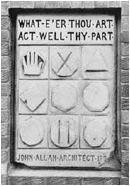 The original stone was purchased and moved from Scotland to Salt Lake City, Utah and now resides in the Museum of Church History in Salt Lake City, Utah.
The original stone was purchased and moved from Scotland to Salt Lake City, Utah and now resides in the Museum of Church History in Salt Lake City, Utah.
Utah Standard News depends on the support of readers like you.
Good Journalism requires time, expertise, passion and money. We know you appreciate the coverage here. Please help us to continue as an alternative news website by becoming a subscriber or making a donation. To learn more about our subscription options or make a donation, click here.
To Advertise on UtahStandardNews.com, please contact us at: ed@utahstandardnews.com.



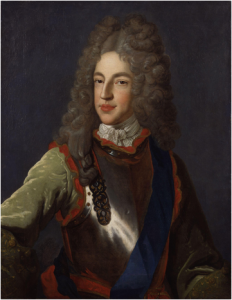
Comments - No Responses to “February 4 Scots Book of Days”
Sure is empty down here...